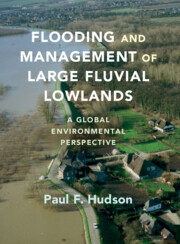Refine search
Actions for selected content:
2664 results in Civil and geotechnical engineering
Dedication
-
- Book:
- Flooding and Management of Large Fluvial Lowlands
- Published online:
- 04 November 2021
- Print publication:
- 25 November 2021, pp v-vi
-
- Chapter
- Export citation
Index
-
- Book:
- Flooding and Management of Large Fluvial Lowlands
- Published online:
- 04 November 2021
- Print publication:
- 25 November 2021, pp 326-330
-
- Chapter
- Export citation
Figures
-
- Book:
- Flooding and Management of Large Fluvial Lowlands
- Published online:
- 04 November 2021
- Print publication:
- 25 November 2021, pp ix-xiv
-
- Chapter
- Export citation
5 - Hydraulic Engineering for Channel Stability and Flood Control
-
- Book:
- Flooding and Management of Large Fluvial Lowlands
- Published online:
- 04 November 2021
- Print publication:
- 25 November 2021, pp 138-165
-
- Chapter
- Export citation
2 - Rivers and Landscapes
-
- Book:
- Flooding and Management of Large Fluvial Lowlands
- Published online:
- 04 November 2021
- Print publication:
- 25 November 2021, pp 9-30
-
- Chapter
- Export citation
Bibliography
-
- Book:
- Flooding and Management of Large Fluvial Lowlands
- Published online:
- 04 November 2021
- Print publication:
- 25 November 2021, pp 298-325
-
- Chapter
- Export citation
Preface and Acknowledgments
-
- Book:
- Flooding and Management of Large Fluvial Lowlands
- Published online:
- 04 November 2021
- Print publication:
- 25 November 2021, pp xvii-xviii
-
- Chapter
- Export citation
9 - Lessons Learned
-
- Book:
- Flooding and Management of Large Fluvial Lowlands
- Published online:
- 04 November 2021
- Print publication:
- 25 November 2021, pp 284-297
-
- Chapter
- Export citation
6 - Dikes and Floodplains
-
- Book:
- Flooding and Management of Large Fluvial Lowlands
- Published online:
- 04 November 2021
- Print publication:
- 25 November 2021, pp 166-204
-
- Chapter
- Export citation
8 - Toward Integrated Management of Lowland Rivers
-
- Book:
- Flooding and Management of Large Fluvial Lowlands
- Published online:
- 04 November 2021
- Print publication:
- 25 November 2021, pp 249-283
-
- Chapter
- Export citation
Tables
-
- Book:
- Flooding and Management of Large Fluvial Lowlands
- Published online:
- 04 November 2021
- Print publication:
- 25 November 2021, pp xv-xvi
-
- Chapter
- Export citation

Flooding and Management of Large Fluvial Lowlands
- A Global Environmental Perspective
-
- Published online:
- 04 November 2021
- Print publication:
- 25 November 2021
References
-
- Book:
- Seismic Hazard and Risk Analysis
- Published online:
- 14 December 2021
- Print publication:
- 21 October 2021, pp 533-571
-
- Chapter
- Export citation
8 - Non-Ergodic Hazard Analysis
-
- Book:
- Seismic Hazard and Risk Analysis
- Published online:
- 14 December 2021
- Print publication:
- 21 October 2021, pp 319-366
-
- Chapter
- Export citation
5 - Physics-Based Ground-Motion Characterization
-
- Book:
- Seismic Hazard and Risk Analysis
- Published online:
- 14 December 2021
- Print publication:
- 21 October 2021, pp 196-246
-
- Chapter
- Export citation
2 - Seismic Source Characterization
-
- Book:
- Seismic Hazard and Risk Analysis
- Published online:
- 14 December 2021
- Print publication:
- 21 October 2021, pp 19-58
-
- Chapter
- Export citation
Part III - Risk
-
- Book:
- Seismic Hazard and Risk Analysis
- Published online:
- 14 December 2021
- Print publication:
- 21 October 2021, pp 367-368
-
- Chapter
- Export citation
1 - Introduction
-
- Book:
- Seismic Hazard and Risk Analysis
- Published online:
- 14 December 2021
- Print publication:
- 21 October 2021, pp 1-16
-
- Chapter
-
- You have access
- Export citation
10 - Ground-Motion Selection
-
- Book:
- Seismic Hazard and Risk Analysis
- Published online:
- 14 December 2021
- Print publication:
- 21 October 2021, pp 404-446
-
- Chapter
- Export citation
Appendix B - Basics of Statistics for Model Calibration
-
- Book:
- Seismic Hazard and Risk Analysis
- Published online:
- 14 December 2021
- Print publication:
- 21 October 2021, pp 519-532
-
- Chapter
- Export citation
